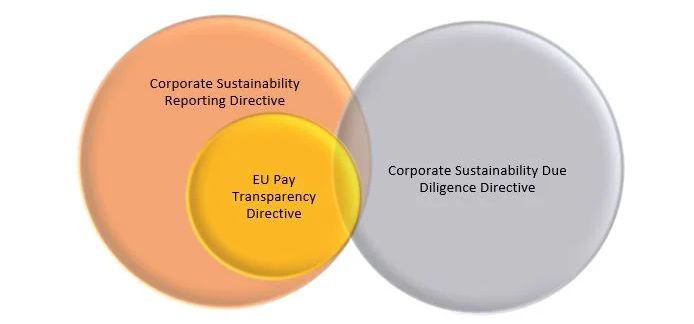In Short
The Situation: While U.S. states continue to legislate pay equity and transparency obligations, significant changes are on the horizon in the European Union that will impact U.S. companies with sizeable operations there. The EU Pay Transparency Directive, adopted in 2023; the EU Corporate Sustainability Reporting Directive, adopted in 2022 ("CSRD"); and the upcoming EU Corporate Sustainability Due Diligence Directive ("CS3D") all include new and far-reaching employer obligations.
The Result: In addition to the requirements under new and existing state laws, U.S.-based employers with operations in the European Union soon will be required to report on gender pay gaps and other compensation-related metrics, including in some instances reports that reflect U.S.-parent company data. Given the sweeping nature of these pay reporting and other requirements, covered employers should begin preparing now.
Looking Ahead: While the ultimate obligations in EU Member States will depend on how the directives are transposed into national laws, all Members States must adopt the minimum requirements in the directives. To prepare for compliance, employers should not only monitor legislative developments, but also proactively review job architecture and pay ranges, as well as consider conducting proactive privileged pay equity studies guided by the requirements of the directives.
Pay Equity and Transparency in the European Union
While only one of three new directives is aimed exclusively at pay transparency, each will have a significant impact on pay disclosures for EU and U.S. employers.

The Pay Transparency Directive has a number of new obligations for EU employers. This Directive came into force in 2023; EU Member States have until June 2026 to implement its requirements into their national laws (i.e., "transpose" the directive). In doing so, each EU Member State ultimately may include more stringent requirements than the Directive itself provides.
The Pay Transparency Directive introduces obligations throughout the employment cycle, which will become effective for large employers in June 2027, including:
- Prior to Employment. The initial salary or initial salary range of the employee's position must be provided to job applicants. Job vacancy announcements and job titles will be required to be "gender-neutral," and the recruitment process must be conducted in a nondiscriminatory basis. Companies will be prohibited from asking applicants about their salary history.
- Disclosure Requirement. Companies above a certain employee threshold will be required to disclose information on gender pay gaps across the company as a whole, and within each category of workers who do the same work or work of equal value. Additionally, the Directive requires reporting on both median and average pay gaps, as well as an analysis of pay components such as base wage or salary, variable pay, and any other "cash or in kind" consideration.
- Joint Pay Assessment Requirement. The Directive requires coordination with the workers' representative to conduct a joint pay assessment in certain circumstances. Specifically, if the gender pay gap for any occupational category is greater than 5% and cannot be justified by gender-neutral criteria, coordination will be required where such gap has not been rectified within six months from the date pay gap information is submitted.
The Directive provides that in transposing it into local law, EU Member States must ensure that any impacted employee may claim and be eligible for full compensation, which will not be subject to any predetermined maximum limit.
CSRD, discussed in a Jones Day White Paper, "Who, What, When: The Impact of the EU CSRD on Non-EU Companies," covers a range of environmental, social & governance topics. CSRD will apply gradually to covered EU companies; large company reporting periods will begin in 2026 (on FY 2025 data).
Notably, the CSRD's pay-related evaluation and potential disclosure obligations are broad; they require covered companies to evaluate gender equality and "equal pay for work of equal value" during mandatory "double materiality" assessments. This means that covered companies are required to identify, and assess, the impacts, risks, and opportunities around equal pay that meet the definition of either financial materiality (i.e., the item has or could reasonably be expected to have a "material influence" on the company's "development, financial position, financial performance, cash flows, [or] access to finance") or "impact materiality" (i.e., "material actual or potential positive or negative impact on people or the environment over the short-, medium-, or long-term").
If pay equity is considered to be material for the company under these standards, the company is required to disclose not only its gender pay gap but also the annual total pay ratio of the highest paid individual to the median annual total pay for all employees. Further, beginning in 2029, CSRD reports of an EU subsidiary must include certain information consolidated at the ultimate U.S. parent company level.
CS3D, discussed in detail in a Jones Day Alert, "Third Time's a Charm: EU Moves to Approve the Sustainability Due Diligence Directive," imposes a range of due diligence and reporting obligations on covered companies regarding, among other things, actual and potential human rights adverse impacts with respect to their own operations, the operations of their subsidiaries, and the operations carried out by their business partners in companies' chains of activities. "Adverse human rights impact" is defined to include impact resulting from "the payment of unequal remuneration for work of equal value."
CS3D was recently adopted by the European Council, which marks the last step in the decision-making procedure; after being signed (considered a formality), the Directive will be published in the Official Journal of the European Union and will enter into force on the 20th day following its publication. Member States will have two years to transpose the new rules into their national laws.
The new rules will apply gradually to EU and non-EU companies and groups of companies from 2027 to 2029. This phase-in is based on the number of employees and net worldwide turnover (for the EU companies) or on the size of the company's presence in the European Union (for non-EU companies).
Pay Equity and Transparency in the United States
The U.S. pay reporting and transparency landscape continues to evolve, with new laws taking effect in 2024 and 2025. For example, beginning October 1, 2024, employers in Maryland must disclose wage ranges and general benefits descriptions in all public and internal job postings, and they must maintain records of compliance for at least three years. Similarly, beginning January 1, 2025, employers in Illinois must include pay scales and general benefits descriptions in job postings, plus they must alert employees about certain promotion opportunities. Maryland and Illinois join other states including California, Colorado, Connecticut, Hawaii, Minnesota, Nevada, New York, Rhode Island, and Washington, as well as the District of Columbia and certain cities, which already have pay transparency laws in effect.
As to reporting, California and Illinois remain the only states that require employers to report employee pay data to government agencies. That said, the Massachusetts legislature recently passed a bill that would require employers to disclose certain employee wage and demographic information to state agencies. Several other state legislatures are considering similar laws.
Not only do these laws create new transparency and pay data reporting obligations for employers, they are the backdrop to the growing trend of lawsuits alleging pay discrimination under state and federal anti-discrimination laws, the federal Equal Pay Act, and state equal pay acts.
Three Key Takeaways
- Given the sweeping nature of the upcoming EU directives, and in light of existing obligations on pay transparency and reporting—including the annual UK gender pay gap reporting obligations for large employers (with 250 or more employees)—employers should consider conducting privileged pay equity analyses to understand any existing risks within their workforce, and remediate existing gaps prior to public disclosure obligations. Because the protections and contours of the attorney–client and other legal privileges vary by jurisdiction, it is important to coordinate with counsel prior to beginning any such analyses to ensure that the project is structured appropriately.
- Employers should review their job architecture and associated pay ranges to ensure they are prepared for job posting disclosure requirements.
- Employers should ensure that their human resources and hiring teams are well-trained on appropriate interview questions and conduct, on job posting rules, and that pay evaluation and promotional decisions are based on a solid compensation philosophy.
The content of this article is intended to provide a general guide to the subject matter. Specialist advice should be sought about your specific circumstances.
We operate a free-to-view policy, asking only that you register in order to read all of our content. Please login or register to view the rest of this article.









